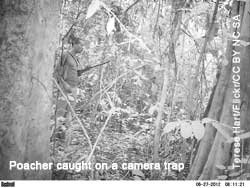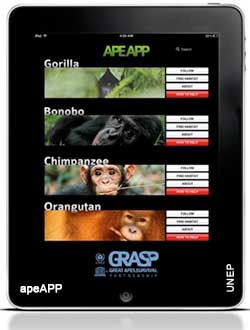Why is this issue important?
Illicit trade in animal parts of iconic species such as elephants, rhinoceroses, tigers and even live great apes is a highly lucrative part
of environmental crime. Demand is based on their use in traditional East Asian medicine, international trade in commercial
goods and exotic pets and a desire for status symbols. Today, illegal wildlife trade is estimated to be worth US$50-150
billion per year (UNEP, 2014). Comparatively, the global illegal fisheries catch is valued at US$10-23.5 billion a year
and illegal logging, including processing, at US$30-100 billion (UNEP, 2014). Illegal ivory trade, for example, has doubled since 2007 (Lawson
and Vines, 2014). Up to 25 000 elephants are killed each year in Africa, out of a total population of 420 000-650 000 (Nellemann et al., 2014).
Ivory provides income to groups such as the Lord's Resistance Army, currently operating in South Sudan, Central African Republic and the
Democratic Republic of Congo. There is also growing evidence that insurgent or militia groups in Africa use profits from the illegal
sales of wildlife to fund terrorist activities (Wyler and Sheikh, 2013; Nellemann et al., 2014). The illegal wildlife trade has also
been linked to organised crime syndicates and cartels that traffic drugs, arms, and money. Poachers threaten the safety of rural
communities, undermine decades of conservation and development, drain source countries of their natural heritage and jeopardise revenue from
activities such as wildlife tourism. The great concern for Africa is loss of revenue from tourism, which creates jobs and contributes resources
for national development. All the while, some species are pushed towards extinction at 1 000 times the natural rate (Pimms et al., 2014).
What are the findings?
Technology has altered the trade of wildlife products including ivory, rhino horn, pangolin scales, exotic birds and live apes.
The Internet has boosted trafficking by lowering barriers of entry into criminal markets, facilitating communication and exchange
of information, as well as reconfiguring relations among supplies, intermediaries and buyers (Lavorgna, 2014). However, technology
can also offer support to national environment, wildlife and law enforcement agencies. In 2013, for example, Chinese authorities
launched "Skynet Action", a key component of which is to stop online wildlife crime and trade with the support of e-commerce websites and companies (CGN, 2013).
As previously reported in an UNEP Global Environmental Alert and elsewhere, drones (unmanned aerial vehicles - UAVs) are being used for conservation (UNEP, 2013a; Platt, 2012).
The Ol Pejeta Conservancy, in Kenya, had planned to deploy UAVs in June 2014 in order to monitor illicit activity and
protect the elephants, rhinoceroses and other threatened species in the Mount Kenya area (Ol Pejeta Conservancy, 2014). Being the largest sanctuary for
rare black rhinos in East Africa, the Conservancy was feeling intense pressure from poachers. But Kenya's government announced on 30 May 2014 that it
had refused to grant approval and abruptly barred the use of private drones, citing "security risks" (DN, 2014). Of the total rhino population of
1 041 individuals at end of 2013, the third largest in the world, Kenya lost 59 rhinos to poachers and an additional 18 by the first quarter of 2014 (KWS, 2014).
The decision to ban the use of surveillance drones in anti-poaching operations underscores the challenges in the battle to halt the illegal trade in wildlife.
Ironically, many of the technological innovations now turned towards poachers were created with pure conservation in mind. Drones are now a vital part of the
anti-poaching arsenal. But Serge Wich, a professor at the Research Center in Evolutionary Anthropology and Paleoecology at Liverpool John Moores University
in the U.K., has long been flying drones over the forest canopy in Southeast Asia to monitor the activity of orangutans. The University of Florida used
drones to monitor alligator populations in the Everglades.
Aside from drones, wildlife and law enforcement agencies are experimenting with other types of technology:
Acoustic Traps
Also known as "echo" technology, acoustic traps are increasingly used to augment traditional anti-poaching patrols and monitor sound waves
for sharp disturbances such as gun shots, chain saws, truck engines, blasts or airplane engines (Wrege et al., 2010; Wrege et al., 2012). Most
systems consist of unattended, monolithic sensors that can be stationed throughout forests, but which then triangulate the source of suspicious
sounds and provide detailed real-time information via a wireless network as to the precise location of the sound. Some are even equipped to
automatically deploy drones or other unmanned aerial devices with GPS headings to collect evidence, photos or infra-red footage.
Mobile Technology
The potential for mobile technology—hand-held devices linked through satellite communications—to empower the general public to
fight back and play a pivotal role is only just being realised. TRAFFIC, the wildlife trade monitoring network, recently launched a
mobile phone application ("app") in collaboration with the Taronga Conservation Society, Australia (TRAFFIC, 2014). The app encourages
the public to report illegal activity involving wildlife, and a host of other apps coming into the marketplace offer similar options.
In Viet Nam, three major mobile phone providers help send text messages to 110 million mobiles promoting public awareness to reduce
demand and stimulate Viet Nam's 90 million population to say no to rhino horns.
The Spatial Monitoring and Reporting Tool (SMART) is an open-source software programme that was created by, and for, the conservation
community in order to engage those on the frontline of fighting wildlife crime in Africa, Asia and elsewhere (SMART, 2014). SMART is
available in six languages and the software is designed to make wildlife conservation activities and wildlife law enforcement patrols
more effective. SMART quickly crunches the data derived from patrols and reports from the field and presents information that can support
quick action. The software has been effectively used by the programme "Monitoring the Illegal Killing of Elephants" (MIKE). The programme
is managed by the Secretariat of the Convention on International Trade in Endangered Species of Wild Fauna and Flora (CITES). Using
field based peer reviewed surveys, MIKE collects data from 51 sites across Africa (CITES, 2014). Other types of software and mobile
apps that can be used to fight wildlife trade crime are described in Box 1 and Box 3.
|
Box 1: CyberTracker
Cybertracker is a software programme that can be installed on computers, smartphones, tablets and rugged handheld devices
through which rangers are able to record geo-referenced information on wildlife, vegetation and signs of human activity. Cybertracker is
used in the field to inform park managers of threats, allowing them to respond quickly and adjust counter-poaching strategies.
In April, the Great Apes Survival Partnership (GRASP) supported an African Apes Initiative (AAI) workshop that trained wildlife
officials from Senegal, Cameroon and DR Congo on the proper use of CyberTracker. Organised by the African Wildlife Foundation (AWF),
the AAI brought park wardens and managers to a remote site in central DR Congo best-known for its wild bonobo populations.
Teams field-tested the TRIMBLE Cybertracker PDA equipment under difficult field conditions.
CyberTracker Conservation is a non-profit organisation that provides CyberTracker software. This software is installed onto
a desktop computer and then uploaded to a smartphone, or tablet computer. The new TRIMBLE PDA offers enhanced GPS, 1D/2D barcode
imaging, smartphone capability, rugged dust and water protection, and Ultra-High Frequency (UHF) radio. Wherever there is a
mobile or satellite network accessible, data is uploaded to park headquarters.
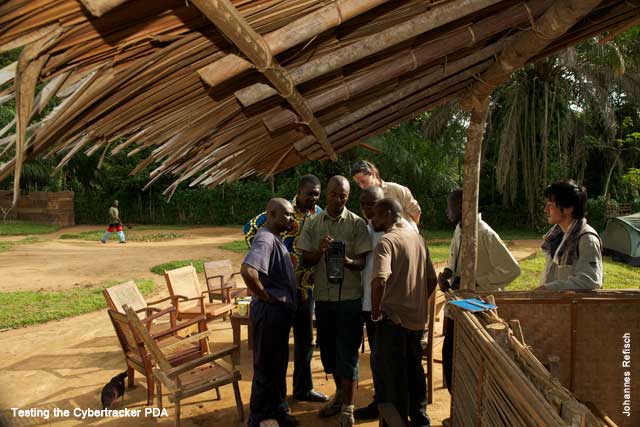
Source: CyberTracker, 2014
|
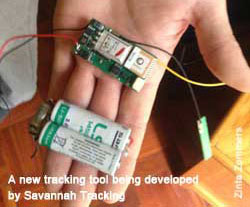
Mikrokopters
Mikrokopters are universal aerial platforms that hover. They can identify a position and hold it as long as necessary to identify images, collect data, or
calculate distances. Most mikrokopters are equipped with GPS, compasses, altitude control, telemetry and automatic systems that report back on altitude,
power consumption, and so forth (HiSystems, 2014). Like drones, mikrokopters can either be pre-programmed to fly specific routes, or operated manually
by means of a control stick and can be equipped with sophisticated camera systems.
Radio Frequency Identification (RFID) Tags
Although most anti-poaching efforts focus on broad national or even regional campaigns, some technology is designed to be implemented one animal
at a time. Radio frequency identification (RFID) tags are microchips that are implanted into specific animals in order to track their movements
through ground or mobile sensors and ensure that the animal is behaving normally. If an animal falls off the grid, RFID captured location
coordinates can help identify the animal's last position and greatly enhance rapid-response capacity. RFID tags are increasingly commonplace in rhino
conservation, where the chip is placed inside the rhino's horn (WWF, 2014; Edwards, 2014).
Military-Style (Mesh) Digital Networks
Mesh networks are digital communications systems that permit sensitive data to be transmitted quickly and safely without
easily being monitored or hacked. One of the biggest problems with mobile technology is that it is available to all, and
poachers are quick to pick up frequencies that monitor collared or micro-chipped animals, giving them a head-start towards
their targets. But Mesh networks, which are now standard among military units, operate through complex routing algorithms
that essentially scramble data upon transmission and then de-code it upon receipt, affording rangers and conservation
teams the opportunity to communicate without poachers being able to listen in. It should be noted that not all mesh networks
have encryption, and not all encrypted networks are mesh networks.
Camera Traps
Camera traps have been monitoring wildlife without human interaction for decades and have been adapted to anti-poaching.
With the advent of highly sophisticated digital cameras and image capture, camera traps are increasingly being used to track
the movement of poachers (Gessner et al., 2014). Recent models come with video feeds, automatic (instead of timed) triggers,
heat sensing, vibration detection, infrared detection, and acoustic elements that can transmit data quickly and accurately (World News, 2014).
Radio Collars
Cumbersome, short-lived radio collars that were once used simply to monitor an animal's movement a few decades ago have been transformed
through advances in satellite technology, permitting researchers access to data that can aid in the fight against poachers (Kagande and
Musarurwa, 2014). Accelerometers inside individual collars can now transmit information such as animal's health and deviations in
ranging patterns—suggesting the presence of poachers. When animals wearing collars meet their collars automatically share data to
expand the network. Innovations in the size, cost and durability of radio collars now means that a growing number of species can be
collared, including tiny birds, rodents and larger elephants and apes (Box 2).
|
Box 2: Conservation Applications
Entrepreneurs in Nairobi, Africa's Silicon Savannah, are creating new tools to track animals and give anti-poaching teams some
leverage. Savannah Tracking Ltd helps biologists use radio collars to monitor elephants, zebras, lions and vultures on the
grasslands. GPS collars are harmlessly attached to animals, along with a mobile phone and batteries. The GPS records the animal's
location every hour. The phone sends the data to a server. Biologists use the data to understand animal movements. Conservationists
use this information to protect wildlife and generate funding. With updated animal locations, anti-poaching teams can be sent to
patrol the right areas. Now a phone app by Savannah Tracking Ltd., MiSavannah, allows the public to follow five animals across
the savannah as well. Location data is delayed so poachers can't use the information. Available from Google Play and the
App Store, 35 per cent of the initial price goes to ten conservation groups.
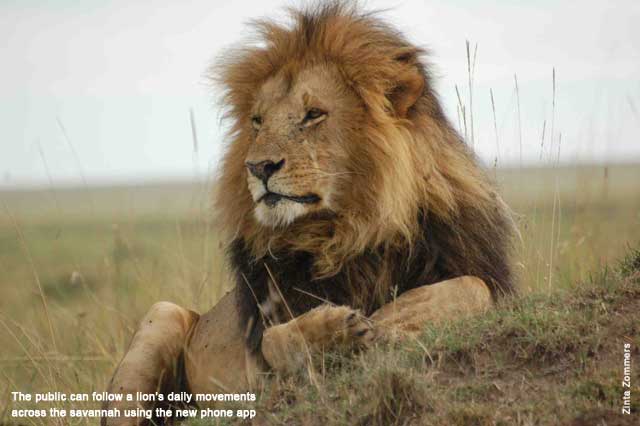
Source: ST, 2013
|
Illegal Trade Databases
A number of databases track aspects of illegal trade, but most are limited by voluntary contributions from countries.
Often they have outdated data that has little relevance to the current situation in the field, or heavy restrictions
regarding privacy and use. Modern databases increasingly embrace ways to be more flexible and involve input from multiple
sources. An example includes the Elephant Trade Information System (ETIS), which tracks confiscation records involving
elephant products and produces quick results. ETIS has been managed by TRAFFIC on behalf of the CITES Parties and is
currently housed at the TRAFFIC East/Southern Africa office in Harare, Zimbabwe.
The Freeland Foundation has worked closely with the private sector technology firms and wildlife specialists to develop a
mobile application to combat wildlife trafficking known as WildScan. The application is designed to help front-line enforcement
agencies, wildlife conservation officers, and the general public to correctly identify, report, and handle marine, freshwater and
terrestrial animals caught in illegal wildlife trade. WildScan features an easy-to-use report function which allows users to
photograph and report wildlife crime. Reports can be confidential or public and those that are shared are displayed on the
home screen so that users can view recent incidents. All reports are forwarded to appropriate law enforcement authorities in
Southeast Asia through the ASEAN Wildlife Enforcement Network (ASEAN-WEN).
Metal Scanners
Wire snares and metal traps used to catch wildlife have been a mainstay of illegal activity for decades, but
poachers are increasingly working to hide their traps by either burying them underground or camouflaging them in
vegetation. In India, TRAFFIC imported standard metal detectors to help forest guards uncover metal tiger traps,
and several organisation in Africa have employed standard wand metal detectors used for airport security to help
teams in the field identify snares (TRAFFIC, 2009). Metal detectors have also played an important role when
investigating crime scenes involving dead or injured wildlife, as they can quickly pinpoint a bullet, which can
be used as evidence and also help identify suppliers.
|
Box 3: GRASP apeAPP monitors illegal trade
The Great Apes Survival Partnership (GRASP) launched a mobile phone application (apeAPP) in 2014 that links the
general public directly to field projects in Africa and Asia, and could play an important role in the battle to halt the illegal trade in great apes.
GRASP partners post updates regarding confiscations and illicit activity. In Indonesia, the Sumatran Orangutan Conservation Programme (SOCP)
offers same-day reports from orangutan rescues, while the Dian Fossey Gorilla Fund International posts issues such as snare removals in Rwanda's
Volcanoes National Park.
Future versions of the apeAPP will allow the general public to submit images or information directly for review for possible inclusion in the great apes illegal trade database.
Source: GRASP, 2014
|
Satellite Imaging
High-resolution images taken from satellites have been used to track illegal deforestation and protected area encroachment for the past decade. Deforestation in
Brazil's Amazon has decreased by up to 78% since 1988, as a result of a "coordinated enforcement approach using satellite imagery and targeted police operations"
(Nelleman et al., 2014). Global Forest Watch, which was launched by the World Resources Institute in February 2014, is a dynamic, online forest monitoring and
alert system that facilitates forest management by combining satellite technology, open data and crowdsourcing to guarantee access to timely and reliable
information about changes in forests (WRI, 2014). Analysts are increasingly making the link between illegally logged areas and the illicit trade in wildlife.
Ships that move contraband timber sometimes also transport illegal wildlife. Furthermore, seemingly innocuous roads cut into virgin forests can lead to the
establishment of massive logging, mining and hunting camps deep in the forest that are impossible to identify from the ground. Satellite imaging can help monitor such changes.
DNA testing
Investigation techniques are increasingly relying on modern forensics and DNA technology. Genetic sequencing is already being used to
fight illegal logging. It can be used to identify wildlife body parts—ivory tusks, or rhino horns, for instance—following a confiscation
in order to confirm the sub-species, country or region of origin, and other static data. The South Africa's Rhino DNA Index System, RhODIS,
has unique DNA profiles for individual rhinos (RhODIS, 2014). If one is killed for its horn, the database aids prosecution. The South African
Government, in partnership with CITES and UNEP, is working to further improve its DNA testing and forensics capacity, strengthening Veterinary
Genetics Laboratories and developing protocols for wildlife crime scene investigation (See Box 4).
DNA profiling is also increasingly being used in cases involving live animals. The University of Barcelona recently produced genetic
profiles of all great apes, allowing those that are confiscated overseas as a result of the illegal live trade to be identified by
country of origin and repatriated, if possible (Prado-Martinez et al., 2013).
|
Box 4: The need for training to assist technology use
In consultation with rhinoceros range States, the International Consortium on Combating Wildlife Crime (ICCWC) identified the need for training on
rhinoceros horn DNA sampling for law enforcement officials. In response to this need, and in support of the implementation of Decisions 16.84
paragraph d) and 16.89 paragraph b) on Rhinoceroses (Rhinocerotidae spp.), the South African Department of Environmental Affairs, the University
of Pretoria's Veterinary Genetics Laboratory and ICCWC co-hosted a rhinoceros DNA sampling workshop on 5 and 6 November 2013 at the Southern
African Wildlife College near Hoedspruit, South Africa. The workshop, which included field training in Kruger National Park, was attended
by law enforcement officers from each of the eleven African rhinoceros range States, as well as from China, Thailand and Viet Nam. The workshop
was made possible by funding generously provided to the ICCWC by the Netherlands.
Source: ICCWC, 2014
|
What are the implications for policy?
A recent Duke University-led study found that emerging technologies could give scientists and policymakers a more efficient way to
identify the species at greatest risk of poaching and help them take measures to protect wildlife before it is too late (Pimm et al., 2014).
"The gap between what we know and don't know about Earth's biodiversity is still tremendous—but technology is going to play a major role in
closing it and helping us conserve biodiversity more intelligently and efficiently," said Lucas N. Joppa, a conservation scientist at
Microsoft's Computational Science Laboratory in Cambridge, U.K. (IUCN, 2014).
Enhanced technology is becoming a priority for governments. The United States Government's National Strategy for Combating Wildlife
Trafficking, which was released earlier this year, emphasised the importance of developing and disseminating cost-effective and
accurate tools (White House, 2014a). Meanwhile, the United States Government launched in 2014 the Technology Challenge on Wildlife
Trafficking through the United States Agency for International Development (USAID). The grant programme is designed to engage the best
and brightest scientists and entrepreneurs to use technological solutions to combat the illegal wildlife trade (White House, 2014b).
The CITES Secretariat has played a leading role in engaging with the private sector to invest in new and emerging technologies, and
in particular through an impact investment fund to be called the Endangered Species Technology and Innovation Fund (World Economic
Forum, 2013). This fund will invest in new technologies to ensure legal, sustainable and traceable trade in wildlife.
The Wildlife Conservation Society's David Wilkie and Robert Rose have called for such a technological investment in an
article in Policy Innovations that warned that poachers were "...escalating the global war on wildlife. Advances such as these [technologies]
would allow conservationists working with government agencies and community conservancies to cover more ground, at more times of day,
with greater safety—patrolling more effectively with negligible change in staff and operating costs," Wilkie and Rose wrote.
"With these advances we can do more than catch poachers: We can prevent the killing in the first place" (Wilke and Rose, 2013).
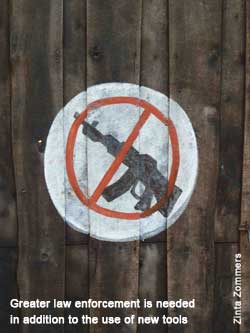
New tools must include those that can contribute to legally allowed evidence used in the courtroom. Although the judicial system
lags behind law enforcement efforts to counter illegal trade—only 27 arrests were made in connection with 1 808 confiscated
great apes between 2005 and 2011, and one-fourth of those 27 arrests were never prosecuted—technology increasingly plays an
important role in the courtrooms (UNEP, 2013b). In Guinea, hidden camera footage of a notorious wildlife dealer recorded him
admitting to exporting "over 500 chimpanzees". This evidence helped earn him a one-year sentence—severe, by wildlife-trade standards.
However, new technologies cannot substitute traditional anti-poaching measures. Some technologies may not be appropriate
for use in low capacity environments, where there is little expertise or technical support. A long term solution will require
efforts to address supply and reduce demand, using methods that encourage deterrence, transparency, legal enforcement,
behavioural change and alternative livelihoods (Nellemann et al., 2014). Broad-scale collective action is needed, and must
include strengthening and harmonising of environmental legislation as well as greater support to those with insufficient
resources to enforce legislation and prosecute smugglers (Lawson and Vines, 2014). Additional empirical evidence and mapping
of transnational crime syndicates and illegal wildlife trade chain would be useful (Lawson and Vines, 2014).
The enhanced technologies being employed to counter the illegal wildlife trade offer hope, and will continue to play a significant role in
conservation. Greater investment is needed to support the increased use of technology by national Governments, wildlife and law enforcement
agencies (Nellemann et al., 2014). New technologies also offer opportunities for collaboration with private sector companies and military
contractors that possess the skill to transform simple innovations—a toy airplane, a metal detector, a mobile phone application—into
the sort of cutting-edge tool necessary to turn the tide of illegal trade.
Acknowledgement
Writers: Douglas Cressa and Zinta Zommers b
Production and Outreach Team: Anna Stabrawab, Arshia Chanderc, Erick Litswab, Charles Sebukeerab, Kim Giesed,
Lindsey Harrimand, Michelle Anthonyd, Reza Hussaind, Tejaswi Girid, Theuri Mwangib and Zinta Zommersb
Special thanks to John E. Scanlone, Julian Blance, Laura Darbya, Thomas Entersf, Jacqueline McGladeb,
Frank Turyatungab, Edoardo Zandrib, Jinhua Zhangb, Monika Macdevetteb and Lindsey Harrimand
for their valuable comments, input and review.
(a United Nations Great Apes Survival Partnership (UN GRASP); b UNEP; c UNEP-RONA; d UNEP/GRID-Sioux Falls; e Convention on
International Trade in Endangered Species of Wild Fauna and Flora (CITES); f UNEP Regional Office for Asia Pacific)
References
Baker, S., Cain, R., Kesteren, F., Zommers, Z., D'Cruze, N., Macdonald, D., 2013. Rough Trade: Animal Welfare in the Global Wildlife Trade. BioScience, 63, 928-938.
CGN, 2013. Forest Police start "Skynet action" to protect wildlife resources. China Government Network (CGN).
http://www.gov.cn/gzdt/2013-04/25/content_2389801.htm (accessed 16.06.14).
CITES, 2014. Elephants poaching and ivory smuggling figures released today. Convention on International Trade in Endangered Species of Wild Fauna and Flora (CITES).
http://www.cites.org/eng/elephant_poaching_and_ivory_smuggling_figures_for_2013_released (accessed 16.06.14).
CyberTracker, 2014. CyberTracker: Discover & Explore Science and Nature. CyberTracker. http://www.cybertracker.org/ (accessed 10.06.14).
DN, 2014. Government bans drone use to fight poaching in Ol Pejeta. Daily Nation Newspaper, 30 May 2014.
http://mobile.nation.co.ke/news/Government-bans-use-of-drone-to-fight-poaching-in-Ol-Pejeta/-/1950946/2332004/-/format/xhtml/-/1wdq78/-/index.html (accessed 16.06.14)
Edwards, J., 2014 World Wildlife Fund Uses RFID to Foil Poachers - A real-time tracking and monitoring solution helps protect endangered rhinos and other animals in Namibia.
Radio frequency identification (RFID) Journal newsletter.
https://www.rfidjournal.com/purchase-access?type=Article&id=11673&r=%2Farticles%2Fview%3F11673 (accessed 17.06.14)
Gessner, J., Buchwald, R., Wittemyer, G., 2014. Assessing species occurrence and species-specific use patterns of bais (forest clearings) in Central Africa with camera traps. African Journal of Ecology 52, 59-68
GRASP, 2014. Mobile conservation on the go! Great Apes Survival Partnership (GRASP). http://www.apeapp.org/ (accessed 06.06.14).
HiSystems, 2014. MikroKopters. HiSystems. http://www.mikrokopter.de/en/home (accessed 15.06.14).
ICCWC, 2014. What is ICCWC? The International Consortium on Combating Wildlife Crime (ICCWC). http://www.cites.org/eng/prog/iccwc.php (accessed 17.06.14).
IUCN, 2014. Press Release - New technologies making it easier to protect threatened species.
http://www.iucnredlist.org/news/new-technologies-making-it-easier-to-protect-threatened-species (accessed 17.06.14)
Kagande, S., and Musarurwa, L., 2014. Conserving the African rhinoceros. Biodiversity Conservation 23, 497-502 DOI 10.1007/s10531-013-0613-2.
KWS, 2014. Kenya Wildlife Service statement on status of wildlife conservation. Kenya Wildlife Service.
http://www.kws.org/info/news/2014/~25marchwildlifestatus2014.html (accessed 17.06.14).
Lavorgna, A. 2014. Wildlife trafficking in the Internet age. Crime Science 3, 5.
Lawson, K. and Vines, A. 2014. The Costs of Crime, Insecurity, and Institutional Erosion. Chatham House.
http://www.chathamhouse.org/publications/papers/view/197367 (accessed 16.06.14).
Nellemann, C., Henriksen, R., Raxter, P., Ash, N., Mrema, E. (Eds). 2014. The Environmental Crime Crisis - Threats to Sustainable Development from Illegal Exploitation and Trade in Wildlife and
Forest Resources. A UNEP Rapid Response Assessment. United Nations Environment Programme and GRID-Arendal, Nairobi and Arendal.
Ol Pejeta Conservancy, 2014. Defining the Future of Drones in Conservation: Ol Pejeta Conservancy and Airware Test the Aerial RangerTM in Kenya.
http://www.olpejetaconservancy.org/about/news/defining-future-drones-conservation (accessed 16.06.14).
Pimm, S., Jenkins, C., Abell, R., Brooks, T., Gittleman, J., Joppa, L., Raven, P., Roberts, C., Sexton, J., 2014. The biodiversity of species and their rates of extinction, distribution, and protection. Science 344, 987-997.
Platt, J. 2012 Eye in the Sky: Drones Help Conserve Sumatran Orangutans and Other Wildlife, Scientific American. September 27, 2012.
http://blogs.scientificamerican.com/extinction-countdown/2012/09/27/drones-help-conserve-sumatran-orangutans-wildlife/ (accessed 06.10.14).
Prado-Martinez et al., 2013. Great ape genetic diversity and population history. Nature 499, 471-475.
RhODIS, 2014. The RhODIS Project. RhODIS Rhino DNA Index System. http://www.rhodis.co.za/ (accessed 16.06.14).
SMART, 2014. SMART conservation tools. SMART. http://smartconservationtools.org/ (accessed 16.06.14).
ST, 2013. Savannah Tracking. http://www.savannahtracking.com/index.php?id=3 (accessed 10.06.14).
TRAFFIC, 2009. Metal detectors uncover hidden traps. TRAFFIC. http://www.traffic.org/home/2009/3/19/metal-detectors-uncover-hidden-traps.html (accessed 16.06.14).
TRAFFIC, 2014. New app to build awareness and information on illegal wildlife trade in South-East Asia. TRAFFIC.
http://www.traffic.org/home/2014/4/9/new-app-to-build-awareness-and-information-on-illegal-wildli.html (accessed 16.06.14).
UNEP, 2013a. A new eye in the sky: Eco-drones. Global Environment Alert Service Bulletin, May 2013. United Nations Environment Programme.
http://www.unep.org/geas/ (accessed 16.06.014).
UNEP, 2013b. Stolen apes - The illicit trade in chimpanzees, gorillas, bonobos and orangutans. A Rapid Response Assessment. United Nations Environment Programme, Grid-Arendal.
UNEP, 2014. UNEP Year Book 2014: Emerging Issues in our Global Environment. United Nations Environment Programme, Nairobi
White House, 2014a. National Strategy for Combating Wildlife Trafficking. US White House.
http://www.worldwildlife.org/publications/national-strategy-for-combating-wildlife-trafficking (accessed 16.06.14).
White House, 2014b. Wildlife Trafficking Technology Challenge. Solicitation Number: SOL-OAA-14-00051.
http://www.whitehouse.gov/sites/default/files/docs/nationalstrategywildlifetrafficking.pdf (accessed 17.06.14).
Wilkie, D., Rose, R., 2013. A Challenge to the World: Build a Better Conservation Drone. Policy Innovation. Wildlife Conservation Society.
http://www.policyinnovations.org/ideas/innovations/data/000254 (accessed 17.06.14).
World Economic Forum, 2013. Creating the Business Case for CITES: A New Financial Mechanism. Global Agenda Council on Governance for Sustainability.
http://www3.weforum.org/docs/GAC/2013/WEF_GAC_GovernanceSustainability_GreenLight_October_Report_2013.pdf (accessed 17.06.14).
World News, 2014. Tech Targeting Wildlife Poachers. April 2, 2014. World News.
http://article.wn.com/view/2014/04/02/Tech_Targeting_Wildlife_Poachers_Photos_WWF_World_Wildlife_F/ (accessed 16.06.14).
Wrege, P., Rowland, E., Thompson, B., Batruch, N., 2010. Use of Acoustic Tools to Reveal Otherwise Cryptic Responses of Forest Elephants to Oil Exploration. Conservation Biology 24(6), 1578-1585.
Wrege, P., Rowland, E., Bout, N., Doukaga, M., 2012. Opening a larger window onto forest elephant ecology. African Journal of Ecology 50, 176-183.
WRI, 2014. Global Forest Watch. World Resources Institute (WRI). http://www.globalforestwatch.org/ (accessed 17.06.14).
WWF, 2014. WWF Tech Integration Helps Namibia Tackle Wildlife Crime - Integrated Airborne and Ground-Based Tech Systems Tested in Namibia to Add New Tools to Protect Elephants,
Rhinos and Other Wildlife.
http://www.worldwildlife.org/press-releases/wwf-tech-integration-helps-namibia-tackle-wildlife-crime (accessed 17.06.14).
Wyler L., Sheikh, P., 2013. International Illegal Trade in Wildlife: Threats and U.S. Policy Congressional Research Service.
http://www.fas.org/sgp/crs/misc/RL34395.pdf (accessed 16.06.14).
If you no longer wish to receive this bulletin you can unsubscribe anytime.
Information is regularly scanned, screened, filtered, carefully edited, and published for educational purposes. UNEP does not accept any liability
or responsibility for the accuracy, completeness, or any other quality of information and data published or linked to the site. Please read our
privacy policy and
disclaimer for further information.








